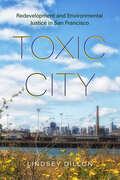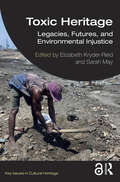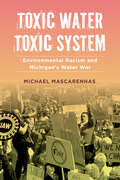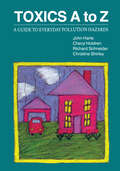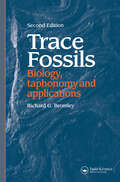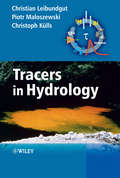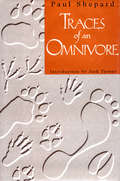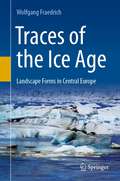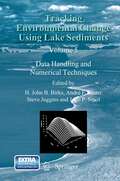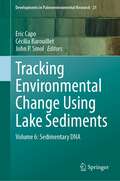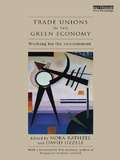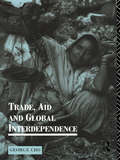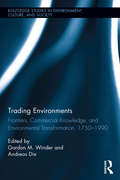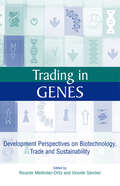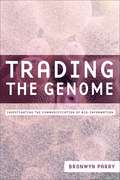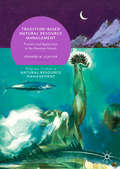- Table View
- List View
Toxic Beauty: The hidden chemicals in cosmetics and how they can harm us
by Dawn MellowshipEvery year we each absorb an estimated 2 kilograms of chemicals through beauty and cosmetic products. Chemicals found in lipsticks, skin lotions and hair dyes have been linked with tumours, cell mutation, allergies, reproductive complications, endocrine disruption and cancer. Isn't it time we all paid more attention to exactly what goes into the eye shadows, body washes and deodorants we love to use? This compelling and timely book tells you the key chemicals you should avoid, reveals just how natural 'organic' beauty products really are, and features a directory highlighting the health issues surrounding a wide range of products, from hair gel to sunscreens.
Toxic City: Redevelopment and Environmental Justice in San Francisco
by Lindsey DillonToxic City presents a novel critique of postindustrial green gentrification through a study of Bayview-Hunters Point, a historically Black neighborhood in San Francisco. As cities across the United States clean up and transform contaminated waterfronts and abandoned factories into inviting spaces of urban nature and green living, working-class residents—who previously lived with the effects of state abandonment, corporate divestment, and industrial pollution—are threatened with displacement at the very moment these neighborhoods are cleaned, greened, and revitalized. Lindsey Dillon details how residents of Bayview-Hunters Point have fought for years for toxic cleanup and urban redevelopment to be a reparative process and how their efforts are linked to long-standing struggles for Black community control and self-determination. She argues that environmental racism is part of a long history of harm linked to slavery and its afterlives and concludes that environmental justice can be conceived within a larger project of reparations.
Toxic Heritage: Legacies, Futures, and Environmental Injustice (Key Issues in Cultural Heritage)
by Sarah May Elizabeth Kryder-ReidToxic Heritage addresses the heritage value of contamination and toxic sites and provides the first in-depth examination of toxic heritage as a global issue. Bringing together case studies, visual essays, and substantive chapters written by leading scholars from around the world, the volume provides a critical framing of the globally expanding field of toxic heritage. Authors from a variety of disciplinary perspectives and methodologies examine toxic heritage as both a material phenomenon and a concept. Organized into five thematic sections, the book explores the meaning and significance of toxic heritage, politics, narratives, affected communities, and activist approaches and interventions. It identifies critical issues and highlights areas of emerging research on the intersections of environmental harm with formal and informal memory practices, while also highlighting the resilience, advocacy, and creativity of communities, scholars, and heritage professionals in responding to the current environmental crises. Toxic Heritage is useful and relevant to scholars and students working across a range of disciplines, including heritage studies, environmental science, archaeology, anthropology, and geography.
Toxic Lake: Environmental Destruction and the Epic Fight to Save Onondaga Lake
by Thomas Shevory2024 Outstanding Academic Title, given by Choice ReviewsThe environmental history of “the most polluted lake in America.”Native Americans have long regarded Onondaga Lake as one of the most sacred spaces in the continent, the place where peace between nations was achieved and the Haudenosaunee Confederacy was created. In the mid-twentieth century, however, it acquired a wholly different reputation as “the most polluted lake in America.” Toxic Lake is an environmental history of this complex ecological system, tracking how it was tarnished, the costly efforts to clean it up, and the controversies those efforts generated.Thomas Shevory argues that the history of Onondaga Lake mirrors the larger environmental history of the US, from colonization to the industrial era, resulting, eventually, in the rise of social movements and legislative action for environmental protection. Layered within this history is the dismissal of indigenous land claims and the marginalization of indigenous voices in clean-up efforts. Toxic Lake illustrates that the failure to prevent the environmental destruction of Onondaga Lake was part of a political climate which favored unregulated industrial production and urban growth, ignoring the destructive impacts on local environments. Shevory argues this larger failure was the result of an active process of privileging the economic interests of polluters over other business interests, expanding neighborhoods, and indigenous rights. He concludes with an investigation of New York’s recent declaration that the clean-up is complete, questioning what exactly that means and whether the lake’s status as a sacred space will ever be re-established. Toxic Lake is a compelling work of history, demonstrating the disastrous effects of pollution and the importance of community involvement in environmental activism.
Toxic Water, Toxic System: Environmental Racism and Michigan's Water War
by Prof. Michael MascarenhasThe tireless resistance of local communities fighting for ownership of America’s third largest water system Toxic Water, Toxic System exposes the consequences of a seemingly anonymous authoritarian state willing to maintain white supremacy at any cost—including poisoning an entire city and shutting off water to thousands of people. Weaving together narratives of frontline activists along with archival data, Michael Mascarenhas provides a powerful exploration of the political alliances and bureaucratic mechanisms that uphold inequality. Drawing from three years of ethnographic fieldwork in Flint and Detroit, this book amplifies the voices of marginalized communities, particularly African American women, whose perspectives and labor have been consistently overlooked. Toxic Water, Toxic System offers a fresh perspective on the ties between urban austerity policies, environmental harm, and the advancement of white supremacist agendas in predominantly Black and brown cities.
Toxic: A Tour of the Ecuadorian Amazon (ethnoGRAPHIC)
by Amelia Fiske Jonas FischerOver the past decade, people have learned about oil contamination in the Ecuadorian Amazon through toxic tours in which a guide brings participants – students, lawyers, environmental activists, journalists, and foreign tourists – to visit contaminated sites. These toxic tours combine personal experience and local knowledge to convince visitors of the immediacy of environmental issues. Drawing on extensive research and fieldwork, Toxic takes the reader on a visual toxic tour through the Amazon. Following the story of three fictional participants, this graphic novel paints a visceral picture of the waste pits, gas flares, and precarious lives of people in this region. The book challenges the reader to consider what it means to live in a place and historical moment where victims of industrial toxicants are continually required to prove that harm has occurred. Toxic is a vivid reflection on the role of pollutants in our everyday lives, ultimately asking readers to reflect on how we are each implicated in the production, consumption, and exposure of pollution both in the Amazon and at home.
Toxicology and Human Health: Environmental Exposures and Biomarkers
by Md. Irshad Ahmad Mohammad Mahamood Mehjbeen Javed Saleh S. AlhewairiniThis contributed volume brings out a comprehensive collection of information on environmental toxicology, its impact on living organisms in general and human health in particular. The main focus of this book is to address human health issues and risk assessment. Toxicological studies help in understanding the impact of harmful substances including both natural and synthetic chemicals on organisms and their environment. Contributions in the title include both laboratory and field based studies with a focus on human health. Moreover, day by day, there is an increase in the range of chemicals from pharmaceutical and other industries, agricultural runoffs, medicine, and many other sources which continuously contribute to the earth's chemical load. Almost all the countries are facing great difficulties in responding to the crucial and immediate need for effective management of such contaminants. The title compiles studies in regards to environmental toxicology and its effect on human health. This book provides critical information and knowledge that can be used by regulatory agencies, decision-makers, policy makers, graduate and post-graduate students, researchers, environmental toxicologists, etc, and others to put programs and policies in place to limit our exposures to these substances thereby preventing or reducing the likelihood that a disease or other negative health outcomes would occur.
Toxics A to Z: A Guide to Everyday Pollution Hazards
by Richard Schneider John Harte Cheryl Holdren Christine ShirleyToxics A to Z features and alphabetical listing of over 100 toxics, identifying . . .What they areHow they are measuredWhere they are foundThe symptoms of exposureWhat their known risks areHow we can lessen or avoid those risksAn easy-to-use Cross-Reference Guide to help readers identify toxics in 18 major groups, including indoor and outdoor air pollutants, household items, and lawn and garden productsA glossary of terms, explanation of abbreviations, and listing of sources for further help and information
Trace Fossils: Biology, Taxonomy and Applications (Developments In Sedimentology Ser. #64)
by Richard G. BromleyThe new edition of this work includes an appendix listing criteria for the identification of ichnotaxa. It covers all aspects of tiering trace fossil diversity and ichnoguilds, and is aimed at advanced undergraduates and postgraduates in palaeoecology, paleobiology and sedimentology.
Trace Metal Biogeochemistry and Ecology of Deep-Sea Hydrothermal Vent Systems
by Liudmila L. Demina Sergey V. GalkinThis volume synthesizes the relevant data that is fundamental to our understanding of trace metal biogeochemistry and the ecology of biological communities of deep-sea vent systems. It presents the combined results of biological and geochemical research and analyzes the microdistribution of animals and the spatial structure of vent communities. Careful consideration is given to the export of iron and other trace metals from hydrothermal vents. The environmental conditions to be found in deep-sea hydrothermal community habitats, along with the trace metal behavior in biotope water are characterized and the sources and forms of trace metals taken up by dominant hydrothermal vent animals are discussed. Special attention is paid to the poorly investigated deep biosphere of the sub-seafloor igneous crust. The book is illustrated with a wealth of exceptional deep-sea photos taken by the manned submersible "Mir", and a dedicated chapter focuses on the role of deep manned submersibles in ocean research. The book will be of interest to researchers and students in the fields of oceanography, geochemistry, biology, the environmental sciences and marine ecology.
Tracers in Hydrology
by Christoph Külls Christian Leibundgut Piotr MaloszewskiTracers in Hydrology and Water Research is a comprehensive overview of the application of natural and artificial tracers in hydrology and environmental research. Taking a unique approach by providing the reader with a systematic and state of the art description of natural and artificial tracers, the book also covers key analytical techniques and applications, and modern tracer methods in the context of systematic hydrology. Tracers have become a primary tool for process investigation, qualitative and quantitative system analysis and integrated resource management. This book will outline the fundamentals of the subject, and examine the latest research findings, clearly showing the entire process of tracer application through the inclusion of numerous integrated case studies.As many techniques derive from different scientific disciplines (chemistry, biology, physics), the effort of compilation and integration into modern hydrology and environmental science research and application requires substantial continuity and experience, which certifies this group of authors.This book will be an invaluable reference not only for students and researchers within the field of Hydrology and Hydrogeology but also for engineers and other tracer techniques applying users.
Traces of Common Xylophagous Insects in Wood: Atlas of Identification - Western Europe
by Magali Toriti Aline Durand Fabien FohrerThis atlas presents a concrete tool to identify xylophagous activity by the remains they left in wooded areas in Western Europe. Xylophagous insects are among the largest predators of woody tissues. They leave discriminating traces, different for each species according to their bioecology, and so it is necessary to know how to recognize and characterize them. The book is a practical tool to help identify and interpret them through a standardized presentation of the most ubiquitous families and a key to their determination. It presents descriptions of the galleries and of morphometry of the faecal pellets based on macroscopic features for xylophagous identification, and includes information about the origin and distribution of the xylophagous biological cycles, bioclimatic conditions and bioecology, and the type of woods that are attacked. The book will be a useful guide for forest managers, heritage conservationists, environmental engineers, bioarchaeologists, entomologists, loggers, and wood anatomists.
Traces of an Omnivore
by Jack Turner Paul ShepardPaul Shepard is one of the most profound and original thinkers of our time. He has helped define the field of human ecology, and has played a vital role in the development of what have come to be known as environmental philosophy, ecophilosophy, and deep ecology -- new ways of thinking about human-environment interactions that ultimately hold great promise for healing the bonds between humans and the natural world. Traces of an Omnivore presents a readable and accessible introduction to this seminal thinker and writer. Throughout his long and distinguished career, Paul Shepard has addressed the most fundamental question of life: Who are we? An oft-repeated theme of his writing is what he sees as the central fact of our existence: that our genetic heritage, formed by three million years of hunting and gathering remains essentially unchanged. Shepard argues that this, "our wild Pleistocene genome," influences everything from human neurology and ontogeny to our pathologies, social structure, myths, and cosmology. While Shepard's writings travel widely across the intellectual landscape, exploring topics as diverse as aesthetics, the bear, hunting, perception, agriculture, human ontogeny, history, animal rights, domestication, post-modern deconstruction, tourism, vegetarianism, the iconography of animals, the Hudson River school of painters, human ecology, theoretical psychology, and metaphysics, the fundamental importance of our genetic makeup is the predominant theme of this collection. As Jack Turner states in an eloquent and enlightening introduction, the essays gathered here "address controversy with an intellectual courage uncommon in an age that exults the relativist, the skeptic, and the cynic. Perused with care they will reward the reader with a deepened appreciation of what we so casually denigrate as primitive life -- the only life we have in the only world we will ever know."
Traces of the Ice Age: Landscape Forms in Central Europe
by Wolfgang FraedrichAt present, we have been living in an ice age for around 2.5 million years, a geological epoch in which there is ice on Earth and in which the curve of the global mean temperature is subject to significant fluctuations (current trend: temperature increase). At nearly 16 million square kilometers, about ten percent of the land surface is currently covered by glacial ice-and glacial ice plays a major role in shaping landscapes. This compact textbook sharpens the eye for such landscapes. It makes the forms and the shaping processes comprehensible, which the author illustrates with numerous regional examples, especially from Central Europe, such as the North German Plain and the Alpine foothills, but also from Iceland. What traces have the glaciers and their meltwaters left behind? What formation processes can be inferred? How can recent climate history, in particular that of the Ice Age, be reconstructed? It is exciting to look at current developments in glaciated areas and also to take a look at the (climate) future of the Earth. For example, the question arises as to what influence glaciers have on sea level and on future climate change. In this context, natural processes such as the ice age cycles, for which there are various ice age formation hypotheses, and anthropogenic influences in global warming must be weighed against each other.
Tracing the Sources and Fate of Contaminants in Agroecosystems: Applications of Multi-stable Isotopes
by Lee Heng Joseph Adu-Gyamfi Grzegorz Skrzypek Gwenaël ImfeldThe objective of this open access book is to present protocols, methodologies, and standard operating procedures (SOPs) used for the identification of sources, transport, and fate of agro-contaminants and illustrate them with several case studies of successful applications. The Soil and Water Management & Crop Nutrition (SWMCN) Subprogramme of the Joint Food and Agriculture Organization (FAO)/International Atomic Energy Agency (IAEA) Centre of Nuclear Techniques in Food and Agriculture, through a Coordinated Research Project (CRP) in partnership with national and international research institutes, developed and evaluated a set of analytical techniques (the toolbox). The toolbox integrates multiple isotope tracers that provide information on the origins and pathways of multiple pollutants through agro-ecosystems, thereby providing more accurate guidance on mitigations. However, land management strategies to address and control the transport of pollutants from soil to water bodies remain the shared responsibility of farm and aquaculture operators, agro-chemical manufacturers, and policymakers in food and agriculture as well as the mining sectors. This book is structured into eight chapters covering (i) an overview of the book’s content, (ii) guidelines for designing water sampling programmes, (iii) the use of mixing models applicable to tracers for water pollution studies, (iv) compound-specific isotope analyses to investigate pesticide degradation in agricultural catchments, (v) the use of stable oxygen isotope composition of phosphate to investigate phosphorous in soil-plant continuum, (vi) the use of stable sulphur isotopes to disentangle agro-pollutants from other contaminants, (vii) nuclear tools used in sediment source apportionment, and (viii) the conclusions and perspectives forward. The book offers up-to-date information, and we hope it is a great source of information for students, researchers, and policymakers. The SWMCN subprogramme thanks all the contributors involved in the preparation of this publication.
Tracking Environmental Change Using Lake Sediments
by John P. Smol H. John Birks Steve Juggins André F. LotterNumerical and statistical methods have rapidly become part of a palaeolimnologist's tool-kit. They are used to explore and summarise complex data, reconstruct past environmental variables from fossil assemblages, and test competing hypotheses about the causes of observed changes in lake biota through history. This book brings together a wide array of numerical and statistical techniques currently available for use in palaeolimnology and other branches of palaeoecology. Visit http://extras.springer.com the Springer's Extras website to view data-sets, figures, software, and R scripts used or mentioned in this book.
Tracking Environmental Change Using Lake Sediments: Volume 6: Sedimentary DNA (Developments in Paleoenvironmental Research #21)
by John P. Smol Eric Capo Cécilia BarouilletThis book, entitled Tracking Environmental Change Using Lake Sediments: Volume 6 – Sedimentary DNA, provides an overview of the applications of sedimentary DNA-based approaches to paleolimnological studies. These approaches have shown considerable potential in providing information about the long-term changes of overall biodiversity in lakes and their watersheds in response to natural and anthropogenic changes, as well as tracking human migrations over the last thousands of years.Although the first studies investigating the preservation of these molecular proxies in sediments originate from the late-1990s, the number of scientific publications on this topic has increased greatly over the last five years. Alongside numerous ecological findings, several sedimentary DNA studies have been dedicated to understanding the reliability of this approach to reconstruct past ecosystem changes. Despite the major surge of interest, a comprehensive compilation of sedimentary DNA approaches and applications has yet to be attempted. The overall aim of this DPER volume is to fill this knowledge gap.
Tracking Trash: Flotsam, Jetsam, and the Science of Ocean Motion (Scientists in the Field Series) (Scientists in the Field)
by Loree Griffin BurnsThe author of The Hive Detectives presents &“a unique and often fascinating book on ocean currents, drifting trash, and the scientists who study them&” (Booklist).Aided by an army of beachcombers, oceanographer Dr. Curtis Ebbesmeyer tracks trash in the name of science. From sneakers to hockey gloves, Curt monitors the watery fate of human-made cargo that has spilled into the ocean. The information he collects is much more than casual news; it is important scientific data. And with careful analysis, Curt, along with a community of scientists, friends, and beachcombers alike, is using his data to understand and protect our ocean.In engaging text and unforgettable images, readers meet the woman who started it all (Curt&’s mother!), the computer program that makes sense of his data (nicknamed OSCURS), and several scientists, both on land and on the sea, who are using Curt&’s discoveries to preserve delicate marine habitats and protect the creatures who live in them.A Boston Globe-Horn Book Award Honor Book for Nonfiction&“Even kids not remotely interested in science might find this work captivating.&”—Newsday &“Loaded . . . with information, insight, and intellectual twists.&”—Natural History Magazine&“The well-written narration will keep readers engaged, and it&’s excellent for reports. The science is clearly explained, and the vivid and lively photographs and well-labeled charts and diagrams help to create interest and build understanding. This title will get readers thinking and possibly acting on these problems.&”—School Library Journal (starred review) &“Scientific information builds from chapter to chapter, creating a natural detective story.&”—Horn Book
Tracking the Literature of Tropical Weather
by Sue Thomas Anne Collett Russell McdougallThis book tracks across history and cultures the ways in which writers have imagined cyclones, hurricanes, and typhoons, collectively understood as "tropical weather. " Historically, literature has drawn upon the natural world for its store of symbolic language and technical device, making use of violent storms in the form of plot, drama, trope, and image in order to highlight their relationship to the political, social, and psychological realms of human affairs. Charting this relationship through writers such as Joseph Conrad, Herman Melville, Gis#65533;le Pineau, and other writers from places like Australia, Japan, Mauritius, the Caribbean, and the Philippines, this ground-breaking collection of essays illuminates the specificities of the ways local, national, and regional communities have made sense and even relied upon the literary to endure the devastation caused by deadly tropical weather.
Trade Unions in the Green Economy: Working for the Environment
by Nora Räthzel David UzzellCombating climate change will increasingly impact on production industries and the workers they employ as production changes and consumption is targeted. Yet research has largely ignored labour and its responses. This book brings together sociologists, psychologists, political scientists, historians, economists, and representatives from international and local unions based in Australia, Brazil, South Africa, Taiwan, Spain, Sweden, the UK and the USA. Together they open up a new area of research: Environmental Labour Studies. The authors ask what kind of environmental policies are unions in different countries and sectors developing. How do they aim to reconcile the protection of jobs with the protection of the environment? What are the forms of cooperation developing between trade unions and environmental movements, especially the so-called Red-Green alliances? Under what conditions are unions striving to create climate change policies that transcend the economic system? Where are they trying to find solutions that they see as possible within the present socio-economic conditions? What are the theoretical and practical implications of trade unions’ "Just Transition", and the problems and perspectives of "Green Jobs"? The authors also explore how food workers’ rights would contribute to low carbon agriculture, the role workers’ identities play in union climate change policies, and the difficulties of creating solidarity between unions across the global North and South. Trade Unions in the Green Economy opens the climate change debate to academics and trade unionists from a range of disciplines in the fields of labour studies, environmental politics, environmental management, and climate change policy. It will also be useful for environmental organisations, trade unions, business, and politicians.
Trade, Aid and Global Interdependence (Routledge Introductions to Development)
by George ChoThere are complex interrelationships between trade, aid and development, and with the move to a greater integration of economies throughout the world, trade has become a vital factor in the economic, social and political development of Third World nations. Trade, Aid and Global Interdependence presents a concise analysis of this vast topic. Trade is introduced as a concept and as an activity; aid and global interdependence are then described in the context of trade in practice. This discussion of the world's shifting patterns of trade is illustrated with case studies from Asia, Africa and Central and Latin America.
Trading Environments: Frontiers, Commercial Knowledge and Environmental Transformation, 1750-1990 (Routledge Studies in Environment, Culture, and Society #4)
by Gordon M. Winder Andreas DixThis volume examines dynamic interactions between the calculative and speculative practices of commerce and the fruitfulness, variability, materiality, liveliness and risks of nature. It does so in diverse environments caught up in new trading relationships forged on and through frontiers for agriculture, forestry, mining and fishing. Historical resource frontiers are understood in terms of commercial knowledge systems organized as projects to transform landscapes and environments. The book asks: how were environments traded, and with what environmental and landscape consequences? How have environments been engineered, standardized and transformed within past trading systems? What have been the successes and failures of economic knowledge in dealing with resource production in complex environments? It considers cases from northern Europe, North and South America, Central Africa and New Zealand in the period between 1750 and 1990, and the contributors reflect on the effects of transnational commodity chains, competing economic knowledge systems, environmental ignorance and learning, and resource exploitation. In each case they identify tensions, blind spots, and environmental learning that plagued commercial projects on frontiers.
Trading in Genes: Development Perspectives on Biotechnology, Trade and Sustainability
by Ricardo Meléndez Vicente SánchezFew scientific developments have given rise to as much controversy as biotechnology. Numerous groups are united in their opposition, expressing concern over environmental and health risks, impacts on rural livelihoods, the economic dominance of multinational companies and the ethical implications of crossing species boundaries. Among the supporters of the technology are those that believe in its potential to enhance food security, further economic development, increase productivity and reduce environmental pressures. As a result, countries - and sectors within countries - find themselves at odds with each other while potential opportunities for development offered by the use of biotechnology are seized or missed, and related risks go unmanaged. This book, a unique interdisciplinary collection of perspectives from the developing world, examines the ongoing debate. Writing for the International Centre for Trade and Sustainable Development, leading experts address issues such as diffusion of technology, intellectual property rights, the Cartagena Protocol, impacts of international trade, capacity building and biotechnology research and regulation. With the most recent and relevant examples from around the world, Trading in Genes offers the reader a single-volume overview of the connections between biotechnology, trade and sustainability that is both wide-ranging and thorough
Trading the Genome: Investigating the Commodification of Bio-Information
by Bronwyn ParryIn a groundbreaking work that draws on anthropology, history, philosophy, business and law, Parry links firsthand knowledge of the operation of the bioprospecting industry to a sophisticated analysis of broader economic, regulatory, and technological transformations to reveal the complex economic and political dynamics that underpin the new global trade in bio-information.
Tradition-Based Natural Resource Management: Practice and Application in the Hawaiian Islands (Palgrave Studies in Natural Resource Management)
by Edward W. GlazierThis book addresses the complex socio-political context of natural resource management in coastal and marine environments throughout the contemporary Pacific Islands and provides lessons that can be applied around the globe. The author spotlights one particular case in which Native Hawaiians worked successfully to develop a formal policy mechanism through which to advise government agencies in the State of Hawaii on matters regarding traditional and customary use and management of the island’s natural resources. Glazier describes historic-traditional aspects of natural resource use and management in the Hawaiian Islands and the challenging process that was employed to enhance the capacity of modern Hawaiians to influence the course of their future. This process successfully broached and addressed truly difficult challenges, including but not limited to: the convening of representatives of a complex society of indigenous persons in order to elicit traditional place-based knowledge and varying perspectives on the appropriate use and management of natural resources; the incorporation of such knowledge and perspectives into the modern natural resource management and policy context; and the need to balance the interests of indigenous persons and those of more recently-arriving persons around the island chain. The lessons learned were many and varied and are particularly germane for resource managers, scientists, policymakers, and indigenous persons seeking to undertake balanced natural resource policy decisions in island, coastal, and indigenous settings around the Pacific and beyond.

